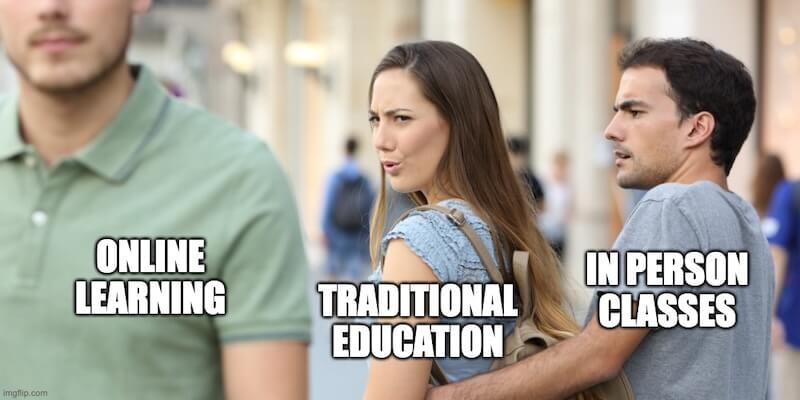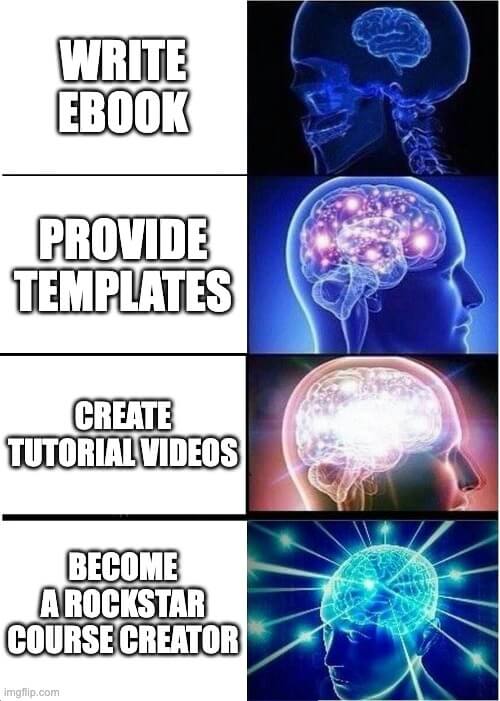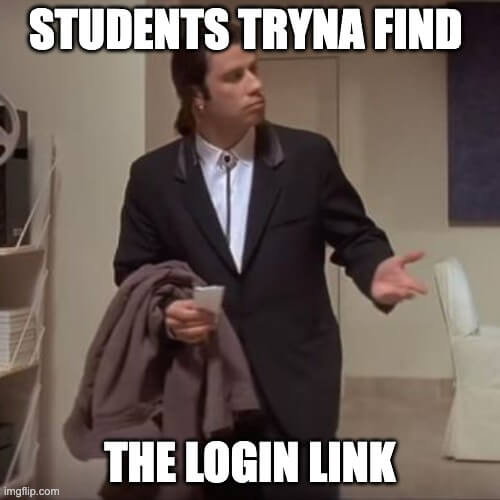If you want to jump straight to the “30 days daily action plan for your course launch”, go here.

This online learning boom is your ticket to teaching, entrepreneurship, and sharing your knowledge with the world. If you’ve always wanted to create your own online course, it’s time to make it happen.

Why Online Courses Are Awesome
Online courses are flexible, scalable, and a great way to establish yourself as an expert in your field. You can reach learners all over the world, make money, and build a loyal following. In this blog, we’re going to walk you through every step of the process — from choosing the right topic to what to do after your launch — so you can launch your course and make it a success.
Oh and did you know online learning is projected to hit $564.7 billion by 2030? Source
Without further ado… here’s the online course creation process…
Choosing and Validating Your Course Topic
What Are You an Expert At and Passionate About?
It all start with choosing a topic:
You love
You are knowledgeable about
This way you’ll be able to keep moving forward during the hard times — and it WILL get hard.
Who do people usually come to you for advice? What skills have you mastered over the years? If you enjoy teaching and helping others, you’re off to a great start.

Do these to validate your online course idea:
Reflect on Your Life: Your personal experiences can be a treasure trove of ideas. What obstacles have you overcome? What were some major wins? Those stories can be powerful lessons for others.
Identify Your Unique Spin: What sets you apart? Your perspective is unique, so highlight what makes you different from the rest.
Stay on Top of Trends: Keep up with what’s popular in online learning and your niche. This will help you choose a topic you’ll love teaching that also has an audience.
Ask Your Network: Bounce course ideas off friends, mentors, or colleagues in your industry. They can give you feedback on what skills are in demand.
Think Big Picture: How does your course fit into your overall career vision? A course that serves your long-term goals will be more enjoyable to create and market.
When you consider these factors, you can choose a course topic you’re excited about that also meets the needs of your students and establishes you as an expert in your field.
Course Launch Next Step: Who Is Your Course For?
Once you’ve chosen a topic, the next step is to identify who your online course is for. This is one of the most crucial steps for the success of your course.
You can have the best course, the best marketing strategy, the best sales tactic… but if you target the wrong audience, no one will buy your course.
What motivates your target audience?
What keeps them up awake at night (i.e. their biggest fear)?
What pain points do they have?
What are their goals?
What are their secret aspirations that they don’t even dare admit to themselves?
Join communities / facebook groups to network with these people.

(thanks to Imgflip for the memes)
Don’t try to sell. Rather, listen and ask questions.
See what they’re complaining about and try to fill these gaps that other courses / resources are not delivering.
The more you understand your audience, the more likely you can create a course that really solves their problems.
Is There Demand?
Before you create your course, make sure there’s demand for it. Browse courses on Udemy or Coursera in your niche. Are people buying? What are they missing?
You can also test the waters by hosting a free webinar or creating a minimum viable product (MVP) of your course. Both of these options will give you feedback and generate buzz for your full course.
To do a deeper dive into market demand, do a competitive analysis. What’s working and what’s not with similar courses? Look at their sales pages, reviews, and student feedback to see what learners love and what’s missing.
You can also ask potential students on social media or in online forums what they think of your course idea. You can get some great feedback and insight into what they need.
A smart strategy you can try is to build a simple landing page with an email opt-in form. Tease what the online course will be and how it can help them. Then at the end invite them to join an email waitlist.
Those who sign up for this waitlist will get special perks like early bird discounts and/or special bonuses.
If no one’s signing up, you need to go back to the drawing board.
Pre-Launch Preparation
Define Your Learning Objectives
Let students know what benefits they can get after they’ve gone through your course.
E.g. By the end of this course, you’ll be able to build a professional looking website using WordPress, even if you don’t know a thing about programming.
As you define your learning objectives, think about what skills and knowledge your students need to succeed in their businesses or with their personal projects. Imagine how these skills will transform their lives. Your learning objectives will guide the way you design your course, so they’re super important.
Your learning goals can also be a major help when it comes to marketing your course. People are a lot more excited to invest in a course when they know exactly what they’ll be able to do by the time they finish. Highlighting your goals on your sales page is a great way to differentiate yourself from the competition and attract more students.
To ensure your learning goals are on target, tie them to industry certifications or standards when possible. This is a great way to add credibility to your course and attract students who are looking to uplevel their careers. Update your goals every so often based on changes in your industry or feedback from students.
Outline Your Course Content
To get started, break down your course into modules and lessons. Each module should cover one main concept, and be broken down into individual lessons. Mix things up by using different formats like video, quizzes, and downloadable resources.
Don’t overwhelm your students with too much information. Make sure each piece of content is powerful and on point.
Take note that different people learn differently — so it’s a good practice to mix in both text and video instead of just creating solely text or video lessons.
Real-life examples and case studies are also a great way to illustrate key points… so that students understand what they’ve just learned.
If you’ve tested your course with beta students, be sure to collect feedback from them. This will help you refine your content and delivery to make your course more effective.
Choose a Platform
What you teach on is almost as important as what you teach. You’ll want an online course platform that’s easy to use and has the features you need to deliver your course successfully. Options like Thinkific and Teachable have built-in payment processing, student management tools, and analytics to make your life easier.
Take some time to research your options and compare platforms based on price, user experience, and customer support.
Create Your Sales Page
This is the landing page where you’ll try to convince folks that your online course can solve their pain points and problems.
You should have these elements in your sales copy:
Intriguing headline
Who it’s for
Unique promise of what your course can do (benefits)
What they will get (features, e.g. how many modules, 10 hours of video, 50 pages of notes)
How to order, including what will happen next when they click the “buy now” button, and what will happen after they’ve paid
Call-to-action (CTA)
Bonuses, templates, worksheets, frameworks
Risk reversal / guarantee
Make sure the sales page loads fast as people these days are impatient. Also make it mobile responsive so that they can easily read on their mobile phones.
Step Up Your Marketing Game
Email Marketing
Your email list is one of the, if not the, most important business assets you can have.
With an email list, you’ll no longer be the mercy of social media or search engine algorithms. You can contact email subscribers at will because you have direct access to their email inboxes.
To persuade people to give you their email address, give away a relevant lead magnet in exchange for their email address. Without this lead magnet bribe, they won’t want to give away their email address.

If you’ve been email marketing for some time, you should be familiar with using your email marketing software (e.g. BirdSend, Mailchimp, etc.) to segment subscribers based on their interests and/or behavior. When you send highly relevant emails, you’ll get a higher engagement rate.
You can also use storytelling in your emails. Share your backstory and why you created the course. This can help you stand out from amongst the thousands of courses out there.
Content Marketing
One of the most obvious ways to promote your online course is with content marketing. If you’ve created a course on a topic you’re passionate about, chances are there’s a lot to say about it. Write blog posts, create YouTube videos or podcasts that teach your audience and preview your course.
Social Media Marketing
It’s a great channel to promote your online course. Use it to build hype and generate excitement before you launch. Share behind-the-scenes peeks at your creation process, countdowns until launch, or sneak peeks of your lessons.
Instagram Stories or LinkedIn posts can be a great way to reach different segments of your audience.
If you want to get fancy, consider collaborating with influencers or other industry experts to help promote your course. Their audience is sure to be interested in your niche, and their endorsement can lend credibility to your course.
Be sure to plan out your content with a content calendar, so you’re posting consistently. Your audience needs time to warm up to you before you launch, and a content calendar will help you deliver valuable content and updates leading up to your launch. You can use Hootsuite or Buffer to schedule your social media posts in advance, so you can focus on engaging with your audience in real time.
Also consider doing polls, quizzes, and live Q&A sessions to get to know your audience better. They’ll also appreciate that you care enough to ask for their opinions and feedback.
Keep an eye on your analytics to see what’s resonating with your audience and adjust your strategy accordingly. Mix organic and paid promotion for the best results. With a little planning and promotion, you can create a buzz and set yourself up for a successful course launch.
Pre-Sell Your Course
Pre-selling your course involves offering early access or a discount to your course before you launch. It’s a great way to earn some income upfront and gauge interest.
Create a pre-sale landing page that outlines what early birds can expect.
Pricing and Revenue Strategy
Define Your Pricing Objectives
Pricing is a major factor in your marketing strategy. You need to set prices that reflect the value your course delivers, but also prices that meet your financial objectives. Take a hard look at your competition. What are they charging for a similar course?
For example, a beginner course is going to be less than an advanced certification course for experienced professionals.
Use Pricing to Create Hype
Most people are price conscious. You can use this to your advantage by creating excitement to whet their appetite.
E.g. 1. Get the course in the next 48 hours to secure your bonuses.
E.g. 2. Get the course in the next 48 hours to claim your 50% discount.
Launch Day
Generate Buzz with Live Events
Live events like webinars or Zoom meetings can be very beneficial sales-wise. Folks get to know you on a deeper level and it shows that you’re not just another scammer trying to rip them off.
You dare to show up with your face, interact with participants, and answer their questions — all these are traits that scammers don’t have.
Be sure to record your webinars and live events, too! People who missed your live events will appreciate the ability to watch or listen at their convenience. And you’ll have some great repurposing opportunities, too. You can create highlight reels or soundbites to share on social media.
Finally, don’t ignore the power of social media. Encourage your attendees to share their experiences on social media using a specific hashtag. It’s a great way to create a buzz and get people promoting you for free. With a solid plan for your live events, you can create a memorable launch day that drives enrollment and builds buzz for your online course.
Launch Funnel Strategy
A solid launch funnel is critical to converting interested people into enrolled students. Your funnel should follow potential students every step of the way, from initial awareness to enrollment. To start, you’ll want to drive traffic to your sales page using email campaigns, social media ads, or blog posts.
To capture people’s attention, your sales page needs to be strong. Use eye-catching headlines, engaging visuals, and clear CTAs to grab people’s attention. Testimonials and case studies are a great way to build trust and showcase the value of your course. You can also offer a trial or sample lesson to hook those curious students and get them enrolled.
For people who aren’t ready to buy right away, retargeting ads can keep your course top of mind. These ads can remind people of the benefits of your course and any limited-time offers you’re promoting. Make sure to follow up with email sequences to convince those who’re still on the fence.
Don’t only hard sell in the emails. Give away useful tips too. Then add some scarcity (limited spots, discount/bonus expiring, etc.) to encourage people to take action.
Delivering Your Online Course
Make sure students / clients / customers know how to access your course — be it self-paced, live sessions, or a combination of both.

If there’s a community aspect to your course, also tell them how they can access it.
To do this, have a clear onboarding process — e.g. record a short video to welcome them and give them a tour of how to access the member area, community, etc.
Content Structure
Here are a few tips when structuring your content:
Deliver your content into bite-sized pieces so that it’s easy for students to digest
Make it practical so it’s easy for students to implement
Consider different learning styles — some prefer to learn via text, others via videos, best is to have both so cover both group
Collaborative activities or study groups are a great way to encourage students to work together and learn from one another. You can also offer one-on-one coaching or mentoring as an add-on to your course. Whatever you choose, be sure to provide plenty of opportunities for students to interact and learn from each other.
Support Your Students
Support doesn’t end at enrollment — it’s an ongoing process. You want to be available to answer questions and provide guidance throughout their learning journey. Set up an email support system, live chats, or dedicated discussion boards where students can ask questions and get help.
You can also use a customer relationship management (CRM) system to help you keep track of student inquiries and follow up with them. When students feel supported, they’re more likely to stick with the course and leave rave reviews.
Regular office hours or live Q&A sessions give students direct access to you, so they can get their questions answered and clear up any confusion. Encourage students to provide feedback on the support they’re receiving, and use that feedback to continually improve your support process.
Post-Course Launch Optimization
Ask For Feedback
Insert feedback cards throughout your course (mid-way through and at the end) to collect feedback from your students. Ask them what they like, what they loathe, and what’s just meh.
Make it easy for them to give you the real tea by making sure surveys are anonymous. And don’t forget to showcase those glowing testimonials in your future marketing efforts.
Consider hosting focus groups or one-on-ones with a handful of students to dig deeper into their experiences. That qualitative feedback can reveal some valuable nuggets that might not show up in survey results. Use it to identify trends and patterns to inform your course changes.
Review Performance Metrics
Apart from asking for feedback, it’s also wise to track these analytics:
Completion rates
Drop off points / times where students seem to lose steam
Knowing these data will allow you to review areas that need to be improved.
Improve
Now that you’ve gotten feedback straight from the horse’s mouth and data from the analytics software, it’s time to make your online course better.
This could mean re-recording videos to make it more concise or to convey certain points in a clearer manner.
Or maybe you could restructure the modules so that your course has a a more logical flow.
And don’t be afraid to get wild and crazy and experiment with new tech like virtual reality (VR) or augmented reality (AR) to create some truly immersive experiences. Students will thank you and it’s a great way to show them practical applications of what they’re learning.
Common Mistakes to Avoid
Even the most well-intentioned course creators make some rookie mistakes that can derail their launch. Here’s a warning about what to avoid:
Failing to Validate Your Market
Launching a course without checking to see if there’s demand is a recipe for disaster. There’s no point in pouring time and effort into a course if no one’s interested. Make sure you validate your idea by surveying your audience, running a pilot program, or checking out what your competitors are offering.
Not Marketing Your Course
No course sells itself. Even if you think you have the greatest course on earth — unless you’re a celebrity — you still need to do marketing to sell it.
Too Much Focus on Making It Pretty Instead of Useful
Unless your course is about “producing Hollywood-style movies” or the likes, it’s more important to focus on making it useful rather than pretty.
What I mean is: it’s better to have “ugly” content that truly helps students rather than “beautiful or high-quality” video recordings that have no substance.
Not Supporting Students / Customers
These people have paid money to be in your program. The last thing you want to do is ignore them. Do the opposite — encourage them to ask questions, then answer them. You want to “wow” them and at the same time make your course better and better.
Not Asking for Testimonials
Marketing and selling courses is not easy, especially with thousands of similar courses to choose from. Don’t be afraid to ask for testimonials. If your course truly can help solve people’s problems, they’ll be more than happy to endorse you.
Not Pre-Selling
Pre-selling helps you get a rough idea of what your audience wants… even before you take the time and energy to build your online course.
Plus it’s a great way to build buzz and create a sense of FOMO (fear of missing out).
By avoiding these common mistakes, you’ll set yourself up for a smoother launch and get better results/
Tools & Resources (e.g. course platforms)
Email marketing software: BirdSend, Mailchimp
Webinar app: Zoom, GoToWebinar
Cart / online checkout system: CartMango, Gumroad
Course platforms: Teachable, Thinkific
Analytics Tools: Google Analytics (for tracking website traffic) and platform-specific dashboards (for monitoring student progress)
Design Tools: Canva (for creating promotional graphics like social media posts)
Investing in these tools can save you time while ensuring a professional experience for both you and your students.
Your Turn
Remember launching isn’t just about selling — it’s about creating an impactful learning experience for your audience. Follow the above tips and the daily action plan below and you’ll be ready to launch your online course with confidence and become a full-time online course creator.
30-Day Roadmap to Launch Your Course
Week 1: Foundation (Days 1–7)
Day 1: Choose Your Topic
Pick a topic you love and are an expert in.
Make sure the topic is relevant to your audience and solves a specific problem.
Day 2: Who is Your Student?
Identify your ideal student by understanding their goals, challenges and pain points.
Survey / interview them to get more nuanced data.
Day 3: Is There Market Demand?
Check existing courses on Udemy or Coursera to see if there’s demand.
Host a free webinar to validate your course idea
Day 4: Who’s Your Competition?
Research competitors’ courses to see gaps in the market.
Identify their strengths and weaknesses so you can make yours stronger.
Day 5: What is The Learning Outcome?
Define what students will learn at the end of the course.
Use SMART (Specific, Measurable, Achievable, Relevant, Time-bound) goals.
Day 6: Structure Your Course
Break down your course into bite-sized lessons using modules and lessons.
Each module should deliver one key concept.
Day 7: Choose Your Checkout System / Course Platform
Compare tools like CartMango, Gumroad, Teachable, Thinkific
Pick one that suits your needs
Week 2: Content (Days 8–14)
Day 8: Plan Your Lessons
Regardless if it’s video or text (or both), it’s important to outline all the content you want to deliver first — like creating a book’s table of content.
Day 9: Record Video Lessons
Set up your recording equipment (doesn’t have to be fancy, your phone or a good quality webcam will do).
Record the first few lessons to test and adjust.
Day 10: Edit Video Lessons
Remember, we’re not trying to produce high-quality, Hollywood-style movies.
Hence, we edit to trim down the video length (to make it more concise) or add to the video to include more information.
Day 11: Create Supporting Materials
Things like templates, worksheets, checklists, etc.
Quizzes and assessments can also be added to improve the learning experience.
Day 12: Upload Content to Your Platform
Organize your content into modules and lessons into your course platform.
Make sure it’s immediately clear for students when they login to their student portal.
Day 13: Create Your Sales Page
Use proven copywriting formulas to sell the benefits of your course
Things like testimonials, case studies, money back guarantees, your backstory, USP
What transformation (before -> after) can they expect after taking your course
Day 14: Set Up Payment Providers
Let customers choose how they want to pay — the most common is via credit card (Stripe) or PayPal
Make sure to test a real purchase. You can set the price to $0.10 for the test purchase.
Week 3: Build Buzz (Days 15–21)
Day 15: Build an Email List
The best way is to give away a RELEVANT lead magnet to your paid course.
This makes it super relevant for folks who’ve gotten the lead magnet. The next natural step is to buy your course.
Use email marketing tools like BirdSend or Mailchimp.
Day 16: Write Your Emails
Write 3-5 emails
Don’t only blatantly promote your course in every email. Instead give away a useful tip, then sell.
This way subscribers won’t be annoyed.
Day 17: Social Media
You can use the emails you’ve written as social content too. You just need to tweak them a bit.
Always leverage your work.
Day 18: Blog Posts / Videos
If you have a blog, you can also reuse your emails and turn them into blog posts.
If you have a YouTube channel, you can also repurpose the emails into videos.
Make sure to link over to your lead magnet at the end of your content.
Day 19: Free Webinar
Consider hosting a free webinar where you give away useful tips relevant to your paid course
Then at the end of the webinar, you softly transition to selling your course
Day 20: Pre-Sell
You can pre-sell your course before officially launching it.
Early birds get a discount and/or exclusive bonuses.
Day 21: Engage with Your Audience
Make sure to monitor your social media and emails.
Answer any questions or comments that come up in a timely manner. This is a great way to show people you care about their questions.
Week 4: Launch Week (Days 22–30)
Day 22: Finalize Funnel
Review all touchpoints in your funnel to make sure everything is consistent.
Test every step of the enrollment process.
Retarget paid ads to people who visited but didn’t enroll.
Day 24: Final Pre-launch Emails
Countdown emails to subscribers.
Reiterate any bonuses or discount to close the sale.
Day 25: Live Q&A
Answer any last minute questions folks have about your online course.
We all want to make a lot of sales, but make sure to be truthful in your answers. If your course is not suitable for someone, tell it like it is. It’s better to lose some initial sales than to ruin your reputation.
Day 26: Launch Day
Write more emails if you need to.
Share the emails as social content too.
Monitor for tech issues. If you encounter any, make sure to quickly fix it as you don’t want to lose sales.
Day 27: Non-buyers Follow Up
Follow up with folks who didn’t buy. Ask them why they didn’t buy.
Don’t be too pushy though. The goal here is to find out why and potentially improve your course or messaging more than trying to close more sales.
Day 28: Engage with Students
Make sure welcome emails are automatically sent to students. Cover how they can access their purchase.
Encourage them to take action and introduce themselves in the community / forum (if you have any).
Day 29: Student Feedback
Monitor if there are issues on course access or feedback on the content and delivery of your course.
Take feedback that makes sense for future improvement.
Day 30: Launch Analysis
Review your stats like sales numbers and conversion rates.
Identify what worked well and what could be improved for future launches.
Related
- SendOwl vs Gumroad: The Recurring Revenue Black Hole (2026)
- Gumroad vs Sellfy: The Vendor Lock-in Cage (2025)
- Gumroad vs Payhip: The Hidden Trap for Creators (2025)
- ThriveCart vs SamCart – The Subscription Hostage Trap (2025)
- 8 ThriveCart Alternatives & The Lifetime Pricing Paradox (2025)
- 8 SamCart alternatives + Subscription hostage (2025)
- The GENTLE Method: Soft marketing for creators
- How Far in Advance Should You Promote a Webinar?
- The SAVINGS Method: The Productivity Improvement Plan for Creators
- 9 Questions to Ask: How to Hire a Digital Marketing Agency
